Claude Lorrain’s painting Rest on the Flight into Egypt (1639, fig. 1) shows the Virgin Mary handing the child Jesus to an angel while a donkey trails behind. A massive tree sprawls across the left half of the scene, shading the family and neatly dividing the painting. Off to the side, Joseph reclines against the tree’s stem, gazing downward as if to examine the ground. In the background, the sky’s blue and orange colors suggest a pleasant sunrise or sunset, and the ruins of a column protrude into the mountains in the back right. Just as the scene depicts a tumultuous time in the life of the Holy Family, its painting comes at a difficult time in both religious and political history. France, Claude’s home country, had bifurcated into Catholic and Huguenot Protestant factions, leading to a series of wars in the late sixteenth century. Meanwhile, doctrinal debates raged over traditional dogmas, or beliefs, about Scripture and religious images. Claude’s painting comes at an important time in the history of Christianity, so naturally his subject matter, form, and style will situate him on certain sides of the political and religious state of his world. It is notable for Claude, seeking to separate himself in his career, to choose an extracanonical scene such as this to paint. Claude arranges the composition so as to emphasize the unity of the Holy Family and Mary’s purity. He manages the level of detail in the painting to upgrade the landscape form to a history painting; his style garnered him a popular Italian market, especially among Catholic clergy. To further his career as an immigrant, Claude created work that remained in accord with his Catholic patrons; the choice of a non-canonical scene such as this goes against the Protestant belief of Sola Scriptura and underscores his Catholic alignment. At a time of polarized politics and religious fracture, Rest on the Flight into Egypt uses a dreamlike landscape and iconographic symbolism to depict a traditional and apocryphal scene while showing Claude’s alignment with the Catholic Church.
Claude’s compositional arrangement demonstrates his historical understanding and alludes to details of the scene. The backstory behind the apocryphal “Rest on the Flight into Egypt” is critical to an iconographic reading of Claude’s painting. Although the original story of the Flight is, “well known to most people in the Christian world,” (Bringéus 323), Nils-Arvid Bringéus points out that, in the Gospel of Matthew, the story, “about the Flight is sparse and bare,” (323). The operative verse notes, “Joseph got up and, taking the child and his mother with him, left that night for Egypt, where he stayed until Herod was dead,” (Matthew 2:15 cf. 323). To fill in the details which the Four Evangelists did not include, the later Gospel of Pseudo-Matthew emerged[1]. In one translation, Pseudo-Matthew recounts that, “when they [the Holy Family] had been traveling about a day, Mary saw a date-palm, full of ripe fruit…but Joseph was so old he did not dare to climb up the tree…but the Christ-Child understood the desire of his mother, and being God, he made the palm bend down…they rested under the date-palm during the night, because there was so much grass that the animals had more than they needed to eat,” (Mathiesen 28 cf. Bringéus 324). This vignette unlocks several compositional choices that Claude makes. First, the tree dominates the left side of the composition, the size of which parallels the importance of the date-palm to the account. Second, the tree’s branches neatly and evenly divide the composition. They extend just over Mary’s body but trail off to reveal the right half’s background sky. Third, the painting shows Joseph’s body in a slanted position leaning against the tree, which evokes the feeling of “rest” that occurs in the story. Similarly, the angel and Mary also sit directly underneath the branches of the tree. Fourth, Joseph’s unwillingness to “climb the tree” is reflected in the painting: his hands and eyes are pointing downward, and his hands appear preoccupied at a lower position rather than reaching up to climb. Fifth, the inclusion of the donkey links back to the line referring to “animals needing to eat”. The donkey is also only partially in view, its legs obscured by the grass and dirt. This implies that the family has reached the top of some hill, and there could be more animals in tow. All of these compositional choices indicate Claude’s knowledge of and allusion to the apocryphal scene.
Beyond the compositional choices, the painting’s stylistic qualities keep the focus on the foreground and the Holy Family. Claude’s style impacts this understanding of the painting’s narrative and meaning. In an essay discussing the possibility of new unpublished paintings being attributed to Claude, Michael Kitson notes, “Claude was so consistent in his aesthetic approach that any strikingly untypical picture by him is hardly to be expected,” (Kitson 84). This “consistent approach” allows one to draw similarities between Rest on the Flight into Egypt and other Claude paintings. Kitson notes how, in Claude’s Liber Veritatis[2] series, the painting Pastoral Landscape (1638, fig. 2) shows, “the ruined building on the opposite bank [to] ac[t] as a complementary focus of visual attraction, and it might be argued that the pale sky and misty hills in the centre are only just strong enough pictorially to hold the two sides of the composition together,” (87). This lack of strength is important for dating the painting, since, “in later years Claude would have given this area greater clarity and firmness of detail. Yet he has largely overcome here the abrupt contrast between foreground and background which mars some of his still earlier works,” (87). These identifiers place both Pastoral Landscape and Rest on the Flight into Egypt around the middle of Claude’s career (Pastoral Landscape was painted a year before Rest on the Flight into Egypt) and both contain stylistic similarities. The hazy and picturesque backgrounds in both paintings serve to both set the scene in a dream-like wonderland while keeping the viewer’s focus more squarely on the characters in the foreground. This contrasts later artists’ works which use a similar dimension - dominant landscape with miniature characters or buildings - to the opposite effect. For instance, Paul Sandby’s A View of Vinters (1794, fig. 3) employs a highly idealized landscape as an aesthetic trick to belie the paper mill’s harsh conditions; as Catherine Labio describes, the mill, “does not assert its presence,” (Labio 54). Although the Holy Family is clear, Claude allows other parts to remain ambiguous. For example, on the question of the sun rising or setting, the book notes that, as is, “often with Claude, the question whether it is a morning or evening light is hard to decide,” (Kitson 87). This ambiguity regarding time of day is thus not limited to Rest on the Flight into Egypt alone: it was a common practice for Claude. In several of Claude’s paintings, the characters are specific, but the background is vague; this well-managed level of detail allows Rest on the Flight into Egypt to remain a painting about the Holy Family.
Since the painting focuses on the Holy Family, Claude’s version positions the characters uniquely to emphasize their unity as well as Mary’s purity. A comparison to other versions of the scene illustrates the differences that Claude chooses to include. The timing of these images is important: Bringéus notes how prints of the scene did not become popular, “until the Counter-Reformation,” (324), which means that artists creating the scene would have motivations based on their religious ties. Michelangelo Caravaggio sets his Rest on the Flight into Egypt (1597, fig. 4) in a similar picturesque natural world to Claude. Paul Barolsky explains how Caravaggio draws on the influence of Giorgione, whose paintings were, “woven through and through with golden thread…[to create] a pastoral dreamworld,” (Barolsky 20). Building on that notion of “dreamworld”, Caravaggio hones in on the part of the biblical narrative in which, “when the Holy Family was in Egypt, an angel of the Lord appeared unto Joseph,” (20). In Caravaggio’s scene, Mary and the child Jesus sleep, which contrasts Joseph in, “rapt attention to the angel, whom he beholds as a vision,” (20). Caravaggio does this to emphasize, “the very awe and wonder of Joseph,” (21). This is the opposite of Claude’s scene, in which Joseph sits awake but looks downcast, not interacting with the angel. Instead, the focal point of the painting is the region between Mary, the child Jesus, and an angel, whose heads form a triangular point of convergence. This shows that Claude’s central triangular composition was an artistic choice, since not every depiction of this scene excludes Joseph in the way that Claude does. And, this artistic choice works to emphasize Mary’s purity. Prior to recounting the Flight, Pseudo-Matthew gives a detailed account of Mary’s childhood, explaining how she became a consecrated virgin and then married Joseph when she was too old to remain in the temple. In The Annunciation, she retains her virginity but allows the Holy Spirit to overshadow her and conceive the child Jesus. Claude mirrors this by excluding St. Joseph from the center and including an angel instead. Joseph was not Jesus’ biological father, and in the Catholic understanding of the Perpetual Virginity, he did not have any children with Mary after the birth of Jesus. To allude to this, Claude’s painting includes an angel, which was not originally mentioned in the account of The Rest. Some versions of the scene did not even include an angel: for example, Johan Sadeler[3], a Flemish artist, engraved a version of The Rest on the Flight into Egypt (1600, fig. 5) with Joseph sitting over Mary’s shoulder, peering at the Child Jesus. Like Claude’s painting, this engraving, “omits the fruit on the twig in front of Joseph,” (Bringéus 329). However, in Claude’s painting, Joseph sits off to the side and does not look towards Jesus. Instead, an angel, a symbol of the paternal Holy Spirit, dotes on Mary rather than a man, which emphasizes Mary’s purity.
Claude’s compositional choices are motivated by the pressures of working within the Italian market. Hermann Voss outlines the circumstances behind Claude’s career. He notes that, “there ensued a constant influx of foreign energies, of painters who during their active years in Rome continued to work in their own inherited manner and who found the international capital by no means lacking in clients,” (8). This explains why someone like Claude might come to Rome, seeking patrons while maintaining his own unique style. Voss continues, “the movement most closely related to the independent tradition of Roman painting was certainly the classicizing and heroicizing current of landscape painting pursued by the French, since indeed this developed from aesthetic aspirations which were also vital within Italian art. Poussin, Dughet, and Claude Lorrain are often distinguished from certain Italian contemporaries…only by the finest nuances...And yet even they remained no more than…compatible aliens on Italian soil [or] outsiders,” (8-9). This shows that, while Claude’s style was very similar to the prevailing Italian style of the High Baroque, he was still seen as an “outsider”. Thus, he had to establish himself within Roman markets, and works like Rest on the Flight into Egypt strove to do this.
To achieve success, Claude relied on his specific style of landscape, which he translated into a strong market among Catholic patrons. Claude followed, “the chief field of Northern artistic creativity in Rome [which] focused chiefly upon landscape painting,” (Voss 9), and Philip Conisbee describes Claude in particular as having, “a dedication to landscape [that] would never waver,” (Conisbee 95). Being around these other landscape artists impacted Claude’s work: Conisbee describes how, “influenced by this generation of artists, Claude’s early compositions consist of receding tracts of land accentuated by tonal modulations from dark foreground to bright green middle ground and icy blue distance,” (95). These signature motifs of Claude’s work appear in Rest on the Flight into Egypt: the hills in the background slowly “recede”, and there is a tonal gradient of solid blue to hazy orange in the top right corner of the painting. Claude uses the sweeping tree branches to create his signature “green middle ground”. Conisbee then praises how, “[Claude’s] style evolved toward the perfected and ordered conception of nature that came to be called ‘ideal landscape’,” (96). With its hazy background and peaceful sky, Rest on the Flight into Egypt is fulfilling this role of “ideal landscape” through its “ordered” composition. Claude also adds a geographic element to this idealized landscape, using Roman ruins as inspiration for the column protruding in the background, even though the scene is from Egypt. All of these traits, part of Claude’s, “stylistically distinctive,” (95) repertoire, show that Rest on the Flight into Egypt is representative of Claude’s technique and style.
This unique style is a byproduct of Claude’s career motivations and patronage. Despite Claude’s proclivity for the landscape, he began including scenes from mythology or religious history within his landscapes such that they would become history paintings, which were more prestigious. His breakthrough painting was one such scene, Coast Scene with Europa and the Bull (1634, fig. 6), which uses the idealized landscape form to depict a scene from Greek mythology. Rest on the Flight into Egypt, which comes from the same decade, is another example of this trend. Also, Claude’s aforementioned anthology Liber Veritatis records an array of destinations, which proves, “an avid international market for Claude’s work,” (95). Among these “destinations” for the now-popular Claude were, “Cardinals Crescenzi, Bentivoglio, Carlo de Medici…Pope Urban VIII; and Giulio Rospigliosi before he became pope,” (95). This demonstrates two things. First, Claude cultivated an extensive market for his work among high-ranking clergy. Second, these Catholic officials specifically liked Claude’s style and method, and they paid him to create for them. Although Claude did not ever paint exclusively religious scenes, his patronage within the Catholic Church reflects the Catholic influence on his paintings.
Having a Catholic patronage became important when the Protestant Reformation divided Europe and forced artists to choose their patronage more carefully. Iara Dundas notes how, after the Reformation, France splintered into, “an increasingly influential Huguenot [Protestant] minority and the Catholic majority,” (Dundas 74). There were initial attempts to resolve these differences through theological means such as the Colloquy of Poissy in 1561. This council saw representatives from both Catholic and Protestant clergy and laymen, and it was meant as a search for compromise. But, as André Thevet notes, “the resulting discussions were acrimonious and the colloquy dissolved itself on 13 October,” (Thevet 45). Then, a series of armed conflicts broke out beginning with the Massacre of Vassy in 1562. While politics eventually cooled off for peace to prevail, a cessation of violence did not mean an end to the religious divide. The 1598 Edict of Nantes, “gave the Huguenots freedom of worship and the control of a large number of fortified towns in southern and western France…[but] raised or debated no theological issues,” (171). This made practicing Protestantism legal (albeit with many restrictions) during the time of Claude’s career. Yet, rebellions persisted into the 17th century, concluding, “with a…siege of the Huguenot stronghold of La Rochelle in 1627 and 1628,” (172). Thus, Claude’s adolescent time in France was one of religious turmoil because of unresolved doctrinal debates spilling over to fighting. These wars and ideological debates pertain to Claude because, as Dundas concludes, “implementation of the Tridentine decrees on France was delayed because of the Wars of Religion, [so] the effect [of Trent] on French art would not be seen until the seventeenth century,” (Dundas 87). Although Claude’s career occurred after the Wars of Religion ended, as a seventeenth century artist, Claude sat at the crossroads of the Catholic-Protestant divide as it pertained to religious art and needed to choose a side.
Choosing to paint a religious scene also held political consequences within Catholicism. Dundas recognizes, “the undercurrents of Gallicism among French Catholics, which viewed papal mandates as secondary to those coming from their divinely appointed king,” (Dundas 72). This subservient version of Catholicism placed the French monarch above the pope, creating a question of authority. Dundas notes that, “French art, especially painting, in the post-Tridentine period can be broadly classified into one of two categories: works that are the result of secular commissions serving to assert the power of the monarchy over a divided kingdom…or religious art,” (72-3). Since Claude is creating “religious art”, he is side-stepping both Gallicism and Protestantism to paint a scene in accord with Catholic doctrine.
Within the divide over religious art, Claude’s decision to include religious characters at all demonstrates his position in the debate about iconoclasm. One of the major differences between Catholics and Protestants was the belief about the role of icons in Christian practice. At the Council of Trent, the Catholic Church clarified its positive position on religious art. This tract notes the importance of religious images because when, “the mysteries of our Redemption [are] portrayed by paintings or other representations, the people [are] instructed, and confirmed in (the habit of) remembering, and continually revolving in mind the articles of faith,” (235). Although Rest on the Flight into Egypt is not an icon specifically intended for religious worship, Claude’s painting nevertheless recalls the mysteries of the birth and infancy of Christ; according to Trent, this makes it useful for instruction. This contrasts the prevailing Protestant belief at the time that religious images were potentially idolatrous. Calvinist churches of the time, such as the one depicted in Pieter Saenredam’s Interior of Saint Bavo, Haarlem (1631, fig. 7), included no images for fear of violating the Second Commandment and committing idolatry. These debates also spilled into violence in riots such as the Beeldenstorm of 1566. Thus, for Claude to paint with religious characters was a controversial decision and an intentional choice, and it places his work in accord with Catholic teaching.
To summarize, Rest on the Flight into Egypt’s idealized landscape depicts an extracanonical scene while pointing to Claude’s allegiance with the Catholic Church. As a French immigrant to Italy, Claude sought to overcome his outsider status and in doing so accumulated a thriving market among high-ranking Catholic officials. So, he created artwork that remained in accord with his Catholic patrons. In Rest on the Flight into Egypt, he chose a scene outside of the Protestant canon of Divine Revelation and painted it in an idealized, picturesque landscape, which underscores his Catholic alignment. And, he arranged the characters to make subtle allusions to the Catholic dogmas that were under threat in his time. Finally, it is important to note the lack of scholarship on Claude’s personal faith. Whether he felt Catholic convictions or not is irrelevant to his artwork, which he nevertheless infused with Catholic sentiments and used as a vehicle to progress his career.
Appendix A: Images Cited
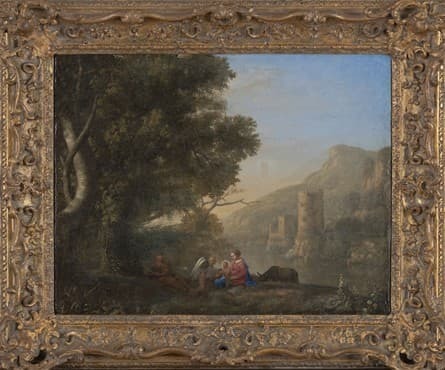


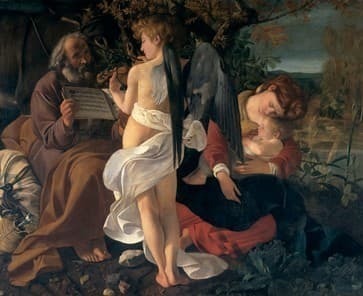
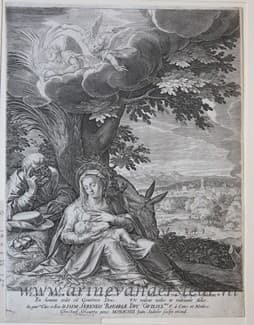
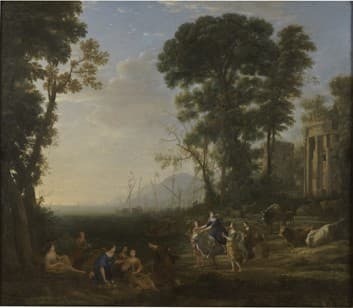
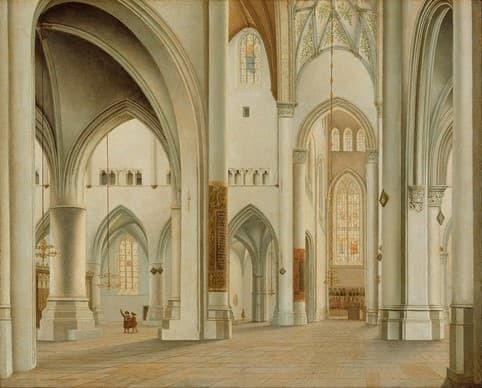
[1] The Gospel of Pseudo-Matthew spans from the birth of the Virgin Mary through the teenage years of Christ. The reasoning behind why Pseudo-Matthew was not accepted as canonical or placed in the traditional Christian Bible is beyond the scope of this paper. Regardless of that debate, it is useful as an early Christian document simply to understand what Christians of that time believed could have happened in Jesus’ early life.
[2] In an effort to prevent forgery or copying, Claude created an album of drawings, Liber Veritatis, in which Philip Conisbee notes how he, “record[ed] virtually every subsequent painting he made with a notation of its date and destination,” (Conisbee 95). It is useful as a historical record because it collates his work and allows for cross-comparison.
[3] There is some debate about whether Sadeler actually created this engraving. Bringéus postulated that Thomas Borup, "found an engraving from Sadeler and in the usual manner made a mirror-copy," (330). Regardless of the real artist, the engraving’s design emphasizes that post-Reformation artists creating versions of “Rest on the Flight” often placed Joseph in or near the center of their compositions, which Claude decidedly avoids doing.
Works Cited
Barolsky, Paul. “The Biblical Poetry of Caravaggio’s ‘Rest on the Flight into Egypt.’” Notes in the History of Art, vol. 10, no. 1, 1990, pp. 20–21. JSTOR, http://www.jstor.org/stable/23202676.
Bringéus, Nils-Arvid. “The rest on the flight into Egypt: A motif in Scandinavian folk art”. Folklore, vol. 114, no. 3, 2003, pp. 323-333. Taylor and Francis Online, https://doi.org/10.1080/0015587032000145360.
Conisbee, Philip. “Claude Lorrain.” French Paintings of the Fifteenth through the Eighteenth Century, Princeton University Press, 2009, pp. 95-112.
Dundas, Iara. “Judgment, Resurrection, Conversion: Art in France During the Wars of Religion.” Art and Reform in the Late Renaissance, edited by Jesse Locker, Routledge, 2019, pp. 72-92.
Kitson, Michael. “Claude Lorrain: Two Unpublished Paintings.” Studies on Claude and Poussin, London, United Kingdom, The Pindar Press, pp. 84-110.
Labio, Catherine. “Belgium is an Industrialist: Pride and Exploitation in the Black Country, 1850-1900.” Voicing Today’s Visions, 2017. University of Chicago Press, 2017, pp. 49-62.
Lagerlöf, Margaretha Rossholm. “Foreward”. Ideal Landscape: Annibale Carracci, Nicolas Poussin, and Claude Lorrain. Yale University Press, 1990, pp. 1-22.
Pope Pius IV. “The Twenty-Fifth Session of the General Council of Trent.” Papal Encyclicals. https://www.papalencyclicals.net/councils/trent/the-complete-text.htm Accessed 2 Apr. 2024.
Thevet, André. Portraits from the French Renaissance and the Wars of Religion. Translated by Edward Benson. Truman State University Press, 2010.
Voss, Hermann. Baroque Painting in Rome II: The High and Late Baroque, Rococo, and Early Neoclassicism. Translated by Thomas Pelzel. Alan Wofsy Fine Arts, 1997.

